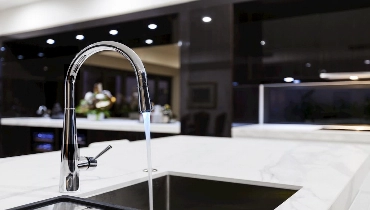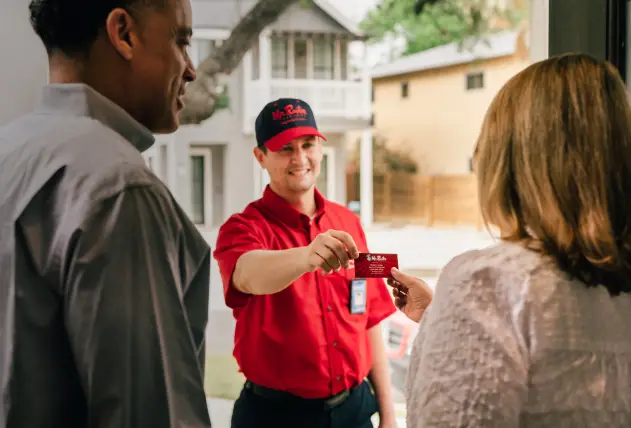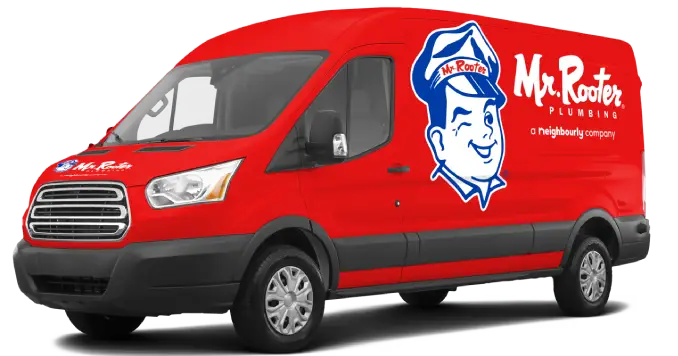
You need your kitchen sink to work properly—especially as it’s one of the most used drains in your home. From cooking meals for your family to washing up, the kitchen sink could get used upwards of six times a day. That’s 2,190 times a year, so no wonder you have a clogged kitchen sink! Calgary’s plumbing technicians know what a nuisance that can be, not to mention the mess that could result from it. Luckily, there are ways to fix this and prevent issues from happening again.
Assuming your kitchen sink is clogged. Our Calgary plumber can give you a few tips on how to prevent future clogs. Our expert team at Mr. Rooter Plumbing of Calgary put together this guide to help you better manage your home’s plumbing system. Not only will you learn some useful DIY strategies for unclogging your kitchen drain, but you will also learn how a professional plumber handles a stubborn drain clog.
Why is My Kitchen Sink Clogged in Calgary?
Food and Debris Stuck in the Drain
Since your kitchen is where you and your family are most likely to consume and throw away food, a lot of that waste gets trapped in the kitchen sink. Whether it's from rinsing dishes, preparing food over the sink or putting too much waste in your garburator, your kitchen sink will get clogged over time. There are actually certain foods that should not be put down the kitchen sink. These include:
- Coffee grinds
- Eggshells
- Bones
- Celery
- Fruit pits
- Pasta
- Potato peels
You may be surprised to learn that there are many foods you should never put down your garburator either. Being aware of what should and should not go down your double sink drains is one of the easiest ways to prevent a clogged kitchen sink in Calgary.
Grease Build Up
Because grease becomes solid at room temperature and is not soluble in water, over time, grease will accumulate on the inside of your drain and cause a blockage. Additionally, grease is very sticky, and other kinds of food and debris could get trapped in it—once again causing you to have a clogged kitchen sink.
It’s much safer to dispose of grease by throwing it in the garbage. The best way to do this is by putting extra cooking grease and oil in a mason jar. Once the jar is full and the grease has solidified, it can be thrown out with the rest of your trash.
Toys and Other Objects
If you have little kids, you may not be surprised to know that toys can become stuck in your kitchen drain or garbage disposal. Perhaps your little one was playing around, or maybe you used the kitchen sink as a baby bath, and some toys got stuck. Toys and other objects are not meant to go down a kitchen sink. These objects will block your pipes and get stuck in your P-trap.
How to Unclog a Kitchen Sink
If you are not comfortable trying to unclog the kitchen sink on your own—or if you have tried and you still can’t get the drain to work—be sure to contact the pros at Mr. Rooter Calgary. We can be reached or via our online contact form.
But if you are ready to learn a few simple DIY solutions for the best way to unclog a kitchen sink, read on to learn what you can do to remove the unwanted blockage.
Remove All Standing Water
Before you tackle the clogged drain itself, it’s important to remove all the standing water in your sink. Standing water is the water stuck in your sink because the sink was still used after a clog had occurred. To bail out the excess water, follow these steps:
- Put on rubber gloves to protect your hands from chemicals or sharp objects—such as kitchen knives—in the sink.
- Use a jug, cup or bowl to remove water from the drain. Flush this water down the toilet or use a different sink in your home to dispose of it. If there are food items in the dirty water, use a basket catch to prevent the food from clogging up another sink or your toilet.
- Remove any visible food debris from the drain. If the drain is attached to a garburator, do not put your hand or fingers near the drain.
Check the Garburator
Even though it is your kitchen garbage disposal’s job to get rid of food waste, it can still become blocked from time to time. Often this is from homeowners putting too much waste down a garburator at once or putting in food items that are not meant to go in the garbage disposal. Foods that shouldn’t be put down the garbage disposal include bones, eggshells and coffee grounds.
To unblock a clogged garburator, follow these steps:
- Firstly, and most importantly, you must turn off your garbage disposal. Do not ever put your hand down the garbage disposal until it has been switched off.
- Use a flashlight to look down the drain to see what is causing the blockage.
- Depending on what you find, determine the best tactic for unclogging the kitchen sink.
- If the block is due to food, then you can either use pliers to remove excess food or manually turn the garburator blades. You can turn the garburator blades using an Allen key. This is located at the bottom of the garburator.
- If your kitchen sink is clogged because there is jewellery trapped in the garburator, you should call our expert plumbers immediately.
- If you can’t remove or break down the food clogging your garbage disposal, try using a plunger. Be sure to clamp the dishwasher drain line before you use a plunger. This prevents dirty water from flowing back into the dishwasher.
- Flush the garburator with hot water to help remove any residual debris.
- Do not pour chemicals down your garburator as this could damage it.
If after plunging your garburator the sink is still clogged, contact us for professional help.
Start with Boiling Water
Using boiling water to flush away excess food is one of the easiest techniques to try and unclog a blocked kitchen sink. By repeatedly flushing boiling water down your sink, you may be able to loosen any drain blockages. It’s important to use boiling water instead of hot tap water because if there is a greasy clog trapped in your sink, the hot water will warm it up and help it move through the pipes. To begin, boil a pot of water on your stove and pour it directly down the drain pipe taking care not to splash it.
Note: Boiling water is not recommended if you have plastic-based pipes, such as PVC or PEX, as it could cause the material to melt.
Try Baking Soda and Vinegar
Another way to unclog your sink without reaching for a plunger or drain snake is by using baking soda and white vinegar. Not only will you avoid chemical cleaners, but the chemical reaction between baking soda and vinegar is particularly good at clearing lightly clogged pipes.
To unclog your kitchen sink with baking soda and vinegar, use the following steps:
- Pour boiling water down the drain. This will begin the drain clearing process and make it easier for the baking soda and vinegar to finish the job.
- Push one cup of baking soda down the sink. Use a wooden spoon or spatula if that feels safer.
- Pour one cup of vinegar down the sink.
- Put the stopper in the sink. This will prevent the vinegar from coming back up and force it to move towards the clog in your kitchen sink.
- Flush with boiling water once the chemical reaction is finished.
Use a Plunger
If you attempted gentler methods in unblocking your clogged kitchen sink in Calgary and they still have not worked, you will have to try using a plunger. There is a right and wrong way to employ this clogged sink solution, so be sure to follow these steps outlining how to unclog your sink with a plunger:
- Pick your plunger. There are three different kinds of plungers: flat-bottom sink plungers, toilet plungers and accordion plungers. Be sure you choose a flat-bottom sink plunger.
- Add a little clean water to the sink. A sink with water a few inches high will help the plunger suck onto the drain.
- Ensure the plunger is submerged under a few inches of water. Create a tight seal around the kitchen sink drain and plunge it a few times.
- Run your garbage disposal (if you have one) to see if that clears the block.
- Test the sink by running some water into it and seeing if it drains.
- If the sink is still clogged, repeat the process three more times.
- If your kitchen sink is still clogged, you should try cleaning the P-trap, using a drain snake or calling a professional plumber.
Clean the P-Trap
Your P-trap is the portion of pipe below your kitchen sink that looks like a “U” or the top portion of a “P.” It serves a variety of functions, including trapping debris and preventing clogs, catching jewellery before your precious items are flushed out with the waste and stopping sewer gases from infiltrating your home.
However, since the P-trap does catch debris and food waste, it can become clogged from time to time. If you think your kitchen sink clog may be in the P-trap, the best thing to do is to take the P-trap apart and clean it out by hand.
The best way to clean out a P-trap is by:
- Placing a bucket underneath the trap to catch any dirty water or debris that may fall out when you remove the trap.
- Unscrew any connections holding the pipe to the wall.
- Remove the P-trap and see if that is where the clog is located.
- If the P-trap is blocked, clean out any debris or gunk and throw this waste away into your garbage.
- If the P-trap is not blocked, then you will have to either use a drain snake or call a professional plumber to get rid of your clogged kitchen sink.
Use a Drain Snake
A drain snake looks like a coiled, metal rope with a crank on one side. The coil goes down into the drain. As the handle is cranked, it pulls up the coil and brings with it any debris that is clogging your kitchen sink. An alternative to a drain snake is a metal hanger that has been straightened out with one end bent like a hook.
To use a drain snake or wire coat hanger to unclog your blocked pipe, follow these steps:
- Prepare your tools, either by readying the drain snake or bending a wire hanger into shape.
- Insert the drain snake or hanger into the drain. If you are using a hanger, ensure it is the bent-hook half that is going into the piece of pipe.
- If you feel anything at the end of the wire, pull it up and out of the drain. You may have to repeat this process a few times.
- Once you have removed as much of the clog as possible, pour boiling water down the sink to get rid of any residual debris.
Call the Pros at Mr. Rooter Plumbing to Fix Your Clogged Kitchen Sink
What happens when you try all of the above methods for how to unclog a kitchen sink with standing water and the water hasn’t budged an inch? Sometimes, a professional plumber is required to get your clogged kitchen sinks in Calgary back to proper working order. Why? While these DIY methods can provide some answers as to how to fix a clogged sink, our skilled plumbers have the expert knowledge and experience needed to remove your tough clog for good.
The truth about some DIY methods is that while they may provide a fast fix, their sink clearing powers won’t last, leaving you with a clog that comes back to haunt you. Homeowners such as yourself don’t always have access to the same kinds of tools professional plumbers do, and that means you’re quite limited in the resolutions you can perform when your sink is backing up. Dealing with a backing up sink isn’t pretty. When plunging, you’ll encounter a lot of gooey black substance, which is essentially rotting hair, skin, and soap scum. Not everyone has the will to deal with gunk like this, so it makes sense that if you prefer to leave your clogged kitchen sinks in the hands of a capable plumber, you would want to.
If you try more than one of these techniques for how to unclog a sink and your sink is still blocked—or if you would prefer the professionals to unclog your kitchen sink, saving you time and hassle—then be sure to call our Calgary plumbers or request a job estimate online.
How to Prevent Future Clogs
Once your kitchen sink has been unclogged, keep in mind the following tips to prevent a future clog so that you don’t have to deal with a blocked kitchen sink in the future:
- Don’t put specific foods down the drain. It’s very important that tough foods, oily foods and fibrous foods do not go in the garburator. This could cause it to clog or break. Food items such as pasta and rice are expandable. That means that while they may seem like small bits of food when they go down, they absorb more water and can become an issue.
- Run water while the garburator is working. This will help flush away the debris as the garburator breaks up food.
- Use a drain cover. A drain cover will protect your drain pipe by catching food particles and other debris.
- Don’t stuff the garburator. You should only put about half a cup of food scraps in the garbage disposal at one time. There are so many food items you should not put down on your garbage disposal, so be sure to check the list of what’s acceptable beforehand. You may be surprised to find that you cannot garburate many of the items you have.
- Invest in regular maintenance. One of the best ways to ensure you will not have a backed up kitchen sink is to regularly upkeep your pipes. Every so often, flush your kitchen sink with boiling water or use the baking soda and vinegar technique to help prevent small blocks from turning into large clogs that require professional help. Avoid chemical drain cleaners at all costs.
The Difference Mr. Rooter Plumbing Makes For Your Clogged Kitchen Sink in Calgary
When you’re down to your last straw and start researching “kitchen sink clogged tried everything,” it’s a sign you need a professional plumbing resolution. Not every home remedy is going to work for every type of clog. While we’ve provided a long list of possible solutions for your clogged kitchen sink, sometimes, relying on a plumber is simply a better solution.
When you do, we’ll arrive promptly at your home, ready to get to work. We’ll inspect your drains and use a professional drain auger to reach deep into your pipes. If your home auger didn’t work, it may not have been long enough to reach the clog. Ours will. What’s more, we will give your drains the cleaning of their life with HydroScrub® Jetting. This powerful blast of water will remove years of build-up and debris to ensure your drain lines are flushed and free from obstructions.
Is your kitchen sink clogged in Calgary? Call the professional and skillful team at Mr. Rooter Plumbing of Calgary. Our team is looking forward to meeting you and making all your plumbing problems go away. We can be reached by phone or by requesting a job estimate online. Whether you’re in Haysboro, Acadia, or Elboya, our plumbing professionals are available to take your call.
